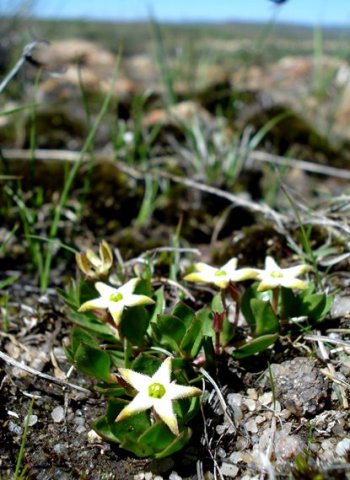Brachystelma

Author: Ivan Lätti
Photographer: Judd Kirkel Welwitch
Brachystelma is a genus of perennials, mainly dwarf plants in the Apocynaceae or milkweed family. The plants contain a watery sap, no milky latex as do many Apocynaceae genera plants. The generic name, Brachystelma, is derived from the Greek words brachus meaning short and stelma meaning short crown or girdle, referring to the usually small corona in the flower centre.
The plants grow from a single, disc-shaped to nearly globose tuber, or from a cluster of spindle-shaped, fleshy roots. One or more stems, creeping or erect, may be grown, the stems sometimes twining. The simple leaves sometimes have petioles.
The flowers grow in stem-tip umbels or umbel-like cymes, also from stem nodes, solitary or in clusters. The individual flowers have pedicels, the flower clusters may have short peduncles. The five sepals often have scales on their inside surfaces.
The five-lobed corollas are nearly flat, bell-shaped or shortly tubular, the tubes shorter than the lobes. These lobes spread or are joined at their tips in a cage-like structure.
The corona arises from the staminal column in the flower centre, occurring in two concentric series. The outer corona is variously five-lobed or ten-teethed (or mini-lobed). The inner corona is smaller-lobed, the lobes opposite the anthers, often linear but in few cases club-shaped. Each anther has two locules, positioned on the staminal column, sometimes erect, without appendages. The pollinia are variously rounded. Some species are odourless, others exude putrid smells.
The fruits are erect, spindle-shaped follicles, usually green, sometimes mottled. The seeds are oblong and sometimes convex on one side with a marginal wing and a hair tuft at one end.
There are more than 100 species of Brachystelma in Africa, Asia and Australia. About 80 of them grow in southern Africa.
The swollen tubers are often eaten by people and animals, sometimes referred to as a famine food. Some species are keenly collected by gardeners and traditional healers. Several species are threatened in nature.
The plant in picture is Brachystelma stellatum (Leistner, (Ed.), 2000; Frandsen, 2017; Wikipedia).

